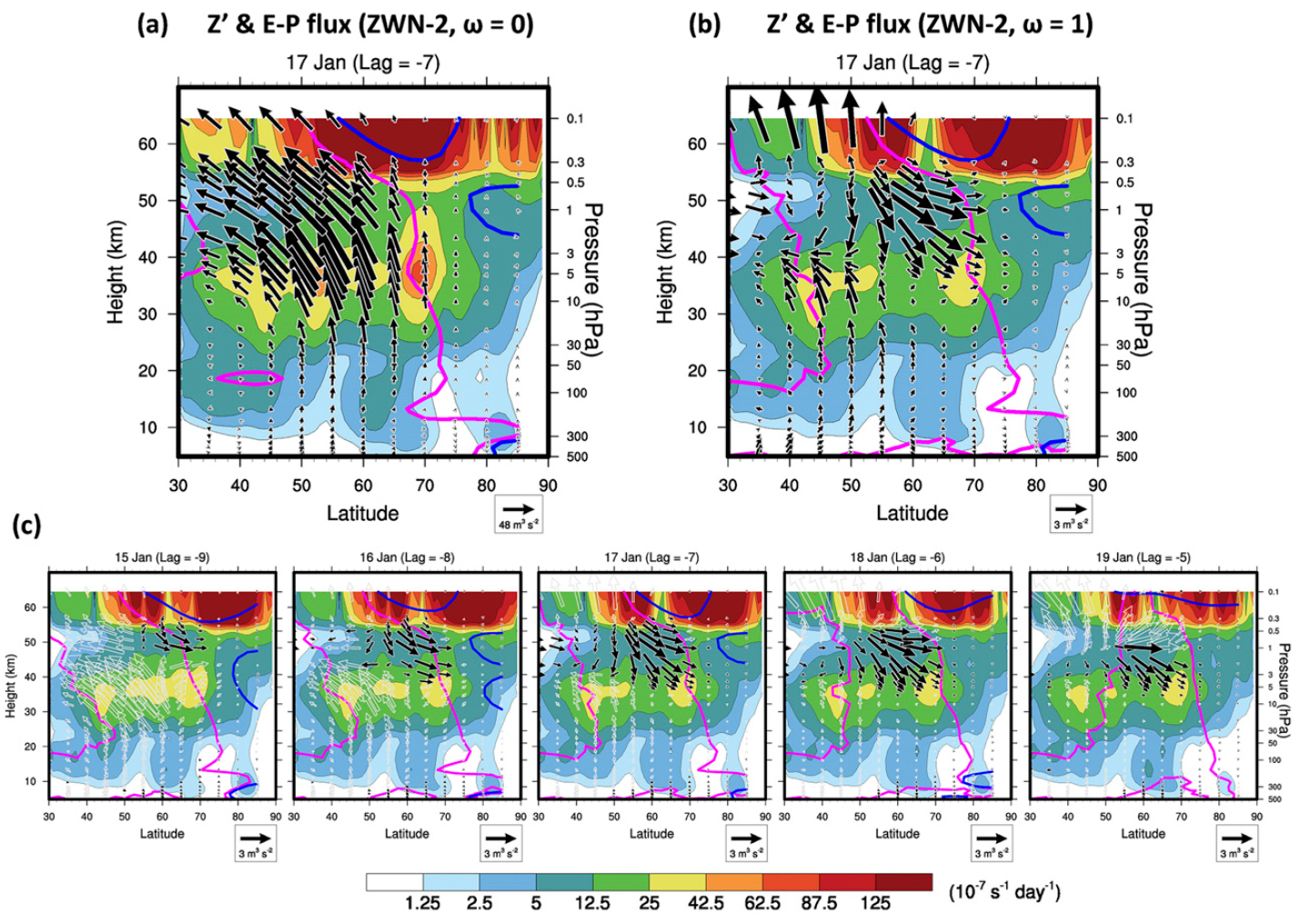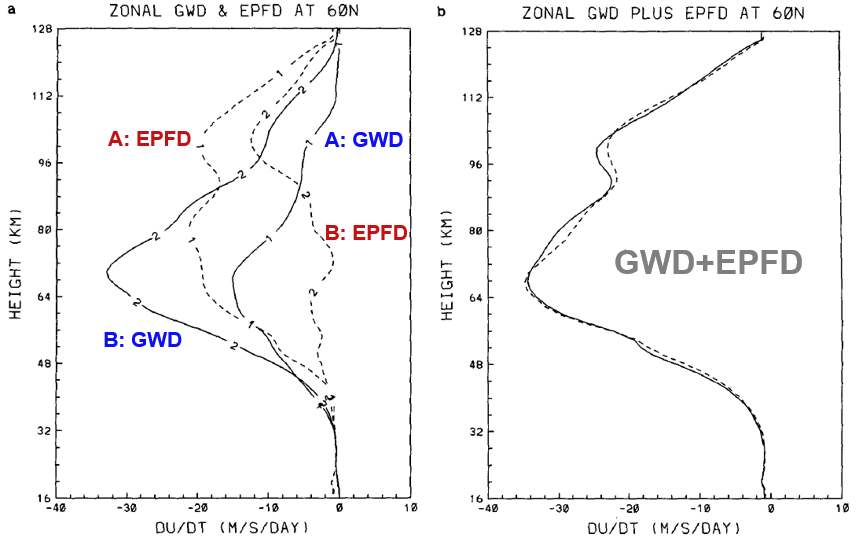<Interactions Between Atmospheric Gravity Waves and Planetary Waves>
Planetary waves (PWs) and gravity waves (GWs) are the primary drivers of the middle atmospheric circulations, where the stratosphere is dominated by PWs and the mesosphere is dominated by GWs.
While PWs generated by the large-scale mountains and land-sea contrast are sufficiently resolved in the general circulation model (GCM), small-scale GWs forced by the small-scale mountains, convection, and jet/front system cannot be resolved properly in most of GCM, and thus, require parameterizations (Kim et al. 2003).
There have been evidences that the PWs and parameterized GWs have strong interactions (Holton 1983, 1984; McLandress & McFarlane 1993; Cohen et al. 2013, 2014; Sato & Nomoto 2015). These interactions work in both directions.
1) PWs embedded in the mean-flow can modify the propagation and dissipation of GWs (smith 2003).
2) GWs can influence on PWs primarily through two ways.
2-1) Momentum forcing of GWs modulates or generates PWs through altering the large-scale mean-flow.
2-1-1) Modify the PW propagation or dissipation condition (Holton 1983)
2-1-2) Drive the barotropic/baroclinic instability which can excite PWs (Sato & Nomoto 2015)
2-1-3) Trigger a resonance of PWs (Albers & Birner 2014)
2-2) Momentum forcing of GWs having zonally asymmetric upward fluxes can generate PWs in situ in the mesosphere (Holton 1984; McLandress & McFarlane 1993; Song et al. 2020).
Song et al. (2020) shows that the amplification of the PWs of zonal wavenumber 2 (ZWN-2) in the stratosphere before the onset of the 2009 sudden stratospheric warming is likely related to the enhanced downward-propagating PWs of ZWN-2 into the stratosphere from above. The enhanced PWs of ZWN-2 are found to be generated by the non-conservative forcing induced by GW drag (NCGWD) in the linearized quasi-geostrophic potential vorticity (QGPV) perturbation equation in the upper stratosphere and lower mesosphere.

<Figure 15 of Song et al. (2020). Latitude-height cross sections of the nonconservative GWD forcing Z’ and the EP fluxes (black vectors) by zonal wavenumber 2 with frequencies of (a) w=0 and (b) w=1 on 17 Jan 2009 (lag = -7). The thick magenta and blue contours indicate zero refractive index and zero meridional PV gradient, respectively. (c) As in (b) but during lag = -9 to lag = -5.>
Idealized numerical experiments with a simple Newtonian cooling relaxed toward a mid-winter radiative equilibrium temperature and simplified GW drag (GWD) having zonally symmetric and asymmetric structures of ZWN-2 also show that
1) PWs with ZWN-2 amplify near the level of maximum imposed GW forcing (about 65 km altitude)
2) Perturbation of the QGPV (q’) is dominated by the NCGWD in the linearized QGPV perturbation equation and is in quadrature with the NCGWD.
This demonstrates that the introduction of a zonal asymmetry to GWD induces the direct in-situ generation of PWs having ZWN-2 (mechanism II) in the middle atmosphere as a non-conservative source for the QGPV perturbation, and thus geopotential height perturbation (H’) of PWs.

<Polar stereography of the advection, NCGWD, and the sum of minus advection and NCGWD (upper) and the perturbation QGPV and the geopotential height amplitude of PW 2 (lower).>
The most interesting phenomenon identified in the GW-PW interaction is compensation between PW and GW forcings: if one component of the system is changed, the others may act to compensate for the change (Figure 2).

<Figure 10 of McLandress and McFarlane (1993). Compensation between GW drag (GWD) and PW drag (PWD). (a) Zonal mean GWD (solid) and EPFD (dashed) at 60N for case A and case B. (b) Sum of GWD and EPFD at 60N for case A (solid) and case B (dashed).>
References
Albers, J. R., & Birner, T. (2014). Vortex preconditioning due to planetary and gravity waves prior to sudden stratospheric warmings. Journal of the Atmospheric Sciences, 71(11), 4028-4054.
Cohen, N. Y., & Gerber, and Oliver Bühler, E. P. (2013). Compensation between resolved and unresolved wave driving in the stratosphere: Implications for downward control. Journal of the atmospheric sciences, 70(12), 3780-3798.
Cohen, N. Y., Gerber, E. P., & Bühler, O. (2014). What drives the Brewer–Dobson circulation?. Journal of the Atmospheric Sciences, 71(10), 3837-3855.
Holton, J. R. (1983). The influence of gravity wave breaking on the general circulation of the middle atmosphere. Journal of the Atmospheric Sciences, 40(10), 2497-2507.
Holton, J. R. (1984). The generation of mesospheric planetary waves by zonally asymmetric gravity wave breaking. Journal of the atmospheric sciences, 41(23), 3427-3430.
Kim, Y. J., Eckermann, S. D., & Chun, H. Y. (2003). An overview of the past, present and future of gravity‐wave drag parametrization for numerical climate and weather prediction models. Atmosphere-Ocean, 41(1), 65-98.
McLandress, C., & McFarlane, N. A. (1993). Interactions between orographic gravity wave drag and forced stationary planetary waves in the winter Northern Hemisphere middle atmosphere. Journal of the atmospheric sciences, 50(13), 1966-1990.
Sato, K., & Nomoto, M. (2015). Gravity wave–induced anomalous potential vorticity gradient generating planetary waves in the winter mesosphere. Journal of the Atmospheric Sciences, 72(9), 3609-3624.
Smith, A. K. (2003). The origin of stationary planetary waves in the upper mesosphere. Journal of the atmospheric sciences, 60(24), 3033-3041.
Song, B. G., Chun, H. Y., & Song, I. S. (2020). Role of Gravity Waves in a Vortex-Split Sudden Stratospheric Warming in January 2009. Journal of the Atmospheric Sciences, 77(10), 3321-3342.
